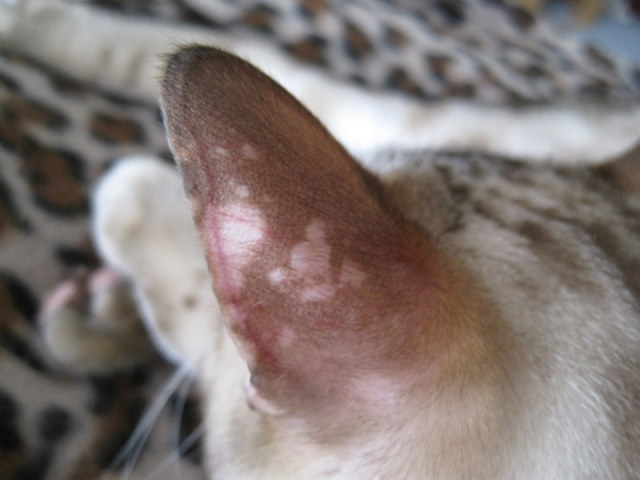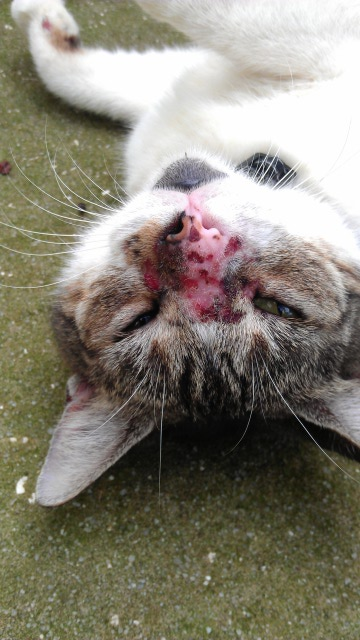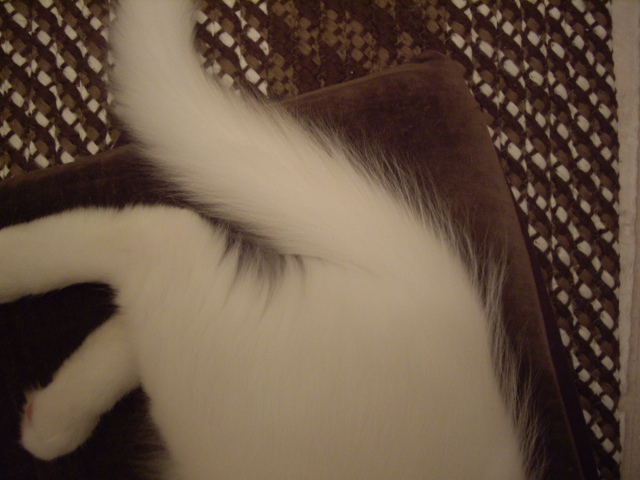Question
 Possible Vitiligo on B
Possible Vitiligo on B
I have a 1 and a 1/2 year old, female, SLP (Seal Lynx Point) Snow Bengal cat. She seems quite strong and healthy, with the exception of having trouble with sinus/allergies (seems to have more trouble breathing on the same days that I do in response to weather, pollen, etc and when she was little would sneeze any time she used the clay litter in her litter box). I recently sent photos of her ears to the breeder I got her from. De-pigmented spots had begun on the outer edge of each of her ears and have been spreading out across her ears in various sized spots. There are no signs of scale, redness, thickness, or any other indicators - only loss of pigment in skin and hair. The breeder contacted some of his mentors in Bengal breeding and I received two possible conditions from them - Ringworm, and Vitiligo. None of the breeders, however, have seen anything quite like what they saw in the photos I sent. I have an appointment to have her cultured in a few days, to check for Ringworm, but I am not certain how much this vet will know about Vitiligo, in order to diagnose it if it is present, as it is apparently quite rare.
After reading up on both conditions, I do not expect it to be Ringworm but, as I understand it, Ringworm can affect a cat in numerous ways so it is best to be sure.
The reading I've done on Vitiligo seems more like what I am seeing on her ears, however I have found no cases of vitiligo occurring on the ears. I have not found cases on Bengals either, though this wasn't surprising. What I have found were sparse reports of Siamese (and supposedly applying to other pointed cats as well) having Vitiligo on their nose, around their eyes, or on their paws.
My questions;
What is your opinion, based on my description, on the Ringworm vs. Vitiligo? Are these conditions easily mistaken, one for the other, before testing? Are there any other conditions that you might suspect aside from Ringworm or Vitiligo?
Is there any reason why Vitiligo might not be likely to occur on the ears?
In cats diagnosed with Vitiligo, how often do you suspect other Auto-immune diseases might be present?
Could her allergies be a factor in the cause of the spotting on her ears, by causing inflammation (hot spots resulting in white spots on a pointed cat)? If so what might you recommend for countering the inflation? Small amounts of Benedryl has been suggested to me...
Are there any reference sources you could suggest for more feline specific information on Vitiligo, especially in the event that my vet is not familiar with the disorder?
Lastly, if it is Vitiligo, do you have any recommendations on safety in choosing a sunscreen to put on her ears (like most cats she loves to lay in the sun when it comes through the windows in the afternoon)?
I apologize for the length of request--please feel free to answer which questions you feel are most relevant.
Thank you.
Amanda
AnswerHi Amanda. Let's see if I can help.
Q. What is your opinion, based on my description, on the Ringworm vs. Vitiligo? Are these conditions easily mistaken, one for the other, before testing?
A. I'm not a vet, but I've seen enough ringworm to say this is definitely not consistent with a typical case of ringworm. With ringworm, you'll see flaky skin and patches of hair loss. I think these tiny, delicate, perfectly formed little white spots are much too neat and defined to be ringworm. It's hard to mistake ringworm for Vitiligo, since Vitiligo causes no skin inflammation and ringworm causes itching, flaking and thickening of the skin and sometimes ulceration.
Q. Are there any other conditions that you might suspect aside from Ringworm or Vitiligo?
A. She hasn't had contact with any chemicals, has she? It almost appears that something may have splashed against her ear. Some cleaners, bleach, for example, are so caustic that they can cause chemical burns that could a loss of pigment.
I agree that this is similar in appearance to vitiligo. The condition is so uncommon that there may be another explanation. One condition that may be responsible is Discoid Lupus, a condition that commonly affects dogs but is also seen in cats. In the beginning stages, it causes depigmentation. It typically causes it on the face and ears first (almost always on the nose in dogs). As the disease progresses, some cats develop scabbing and tissue damage. Other possibilities could be Eosinophilic Granuloma Complex and Pemphigus. When very mild, these may cause enough inflammation under the skin to result in depigmentation without disturbing the outer surface of the skin. However, they generally cause visible ulcerations or pustules, so these are less likely. All of these conditions appear to be auto immune diseases.
Q. Is there any reason why Vitiligo might not be likely to occur on the ears?
A. No, there isn't. Vitiligo in cats is seen most often on the nose, lips and paw pads, but it has also been noted on the ears.
Q. In cats diagnosed with Vitiligo, how often do you suspect other Auto-immune diseases might be present?
A. I'm not sure about this. There are so few cats with Vitiligo, I doubt that a study has ever been conducted to calculate a figure, but we do know that human patients with one auto-immune disease are generally predisposed to others.
Q. Could her allergies be a factor in the cause of the spotting on her ears, by causing inflammation (hot spots resulting in white spots on a pointed cat)? If so what might you recommend for countering the inflation? Small amounts of Benedryl has been suggested to me...
A. If her allergies ever caused skin irritation, then it could certainly be a possibility. Any skin damage can result in a loss of pigmentation. I think that if her ears were hot and inflamed enough to cause the temperature-sensitive color points to lighten in color, the color change would be broader, and you probably would have noticed the inflammation when it was present.
As for treating her allergies, some people do use Benadryl, which is generally considered safe. You should discuss the proper dosage with your vet. There are other antihistamines that can be used in cats, too, if she doesn't respond. Most of them pose a threat of sedation. Cats who don't respond to antihistamines may need a cortisone injection, which is also the treatment for the various auto-immune diseases discussed above.
Q. Are there any reference sources you could suggest for more feline specific information on Vitiligo, especially in the event that my vet is not familiar with the disorder?
A. I'm very excited to have found this for you! It's a little wordy, but it has some great information on Vitiligo, starting at the bottom of page 231:
http://books.google.com/books?id=VKa2Wo3Wc-kC&pg=PA231&lpg=PA231&dq=feline+derma...
Q. Lastly, if it is Vitiligo, do you have any recommendations on safety in choosing a sunscreen to put on her ears (like most cats she loves to lay in the sun when it comes through the windows in the afternoon)?
A. There are some pet sunscreens out there, such as Doggles and UVet, and if you choose to go with a pet sunscreen, be sure it's labeled specifically for cats. The only FDA-approved pet sunscreen, Epi-Pet Sun Protector, is not for use on cats. I have chosen to use Coppertone's Water Babies Pure & Simple SPF 50 on my hairless cat, because after a lot of research, I felt it offered her the most protection with the highest degree of safety. I wasn't highly impressed with the ingredients in the pet sunscreens that I came across. Whether your vet feels your kitty has Vitiligo, Discoid Lupus or is just losing pigment for some other reason, since she likes to lie in the windows, applying sunscreen to her ears, nose and eyebrow area would be a great idea!
Good luck!
Jessica


 old cat not eating
Questionmy cat Tootie xo
QUESTION: I have a 19 y
old cat not eating
Questionmy cat Tootie xo
QUESTION: I have a 19 y
 Cat nose
QuestionCat
QUESTION: There is a stray cat in o
Cat nose
QuestionCat
QUESTION: There is a stray cat in o
 giardia coccidia
Questionthin, spiny guard hair
QUESTION: I took
giardia coccidia
Questionthin, spiny guard hair
QUESTION: I took
 Cant get cat to play
Question
Jules
My male cat Jules is 13. La
Cant get cat to play
Question
Jules
My male cat Jules is 13. La
 Injured tip of ear / Follow up
QuestionBagBoy
QUESTION: My 7-month-old cat, Har
Injured tip of ear / Follow up
QuestionBagBoy
QUESTION: My 7-month-old cat, Har